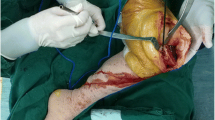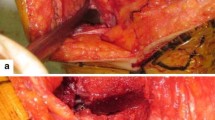Abstract
Purpose
The concept of medial stabilizing technique total knee arthroplasty (MST-TKA) is to minimize the medial release without the superficial layer of medial collateral ligament (MCL). However, it is unclear at what stage the proper medial laxity is obtained during surgery. The purpose of this study was to investigate the implication of deep layer of MCL (dMCL) and osteophyte resection on medial laxity during MST-TKA.
Methods
A total of 103 consecutive patients who underwent cruciate-retaining TKA using the navigation system were included. The intraoperative hip–knee–ankle (HKA) angle was recorded under three conditions (no stress, valgus, and varus stress) at four time points after the resection of the anterior cruciate ligament (ACL) and meniscus (1st evaluation), after the dMCL release (2nd evaluation), and after osteophyte resection on both the femoral and tibial side (3rd evaluation). To assess valgus laxity, the differences in intraoperative HKA angle between 1st and 2nd evaluation (stage 1) and between 2nd and 3rd evaluation (stage 2) were calculated.
Results
Under the valgus stress condition, the intraoperative HKA angle change in stage 2 was significantly larger than that in stage 1 in full extension (stage 1; − 0.5 ± 1.0°, stage 2; − 2.0 ± 1.3°, p < 0.001) and 30° flexion (stage 1; − 0.8 ± 1.4°, stage 2; − 1.5 ± 2.0°, p = 0.008). There were no significant differences at 60° and 90° of knee flexion. Under the no stress and varus stress conditions, there were no significant differences in knee flexion at all angles.
Conclusion
The medial laxity during MST-TKA increased significantly more after dMCL release and osteophyte resection than after just dMCL release at full extension and 30° flexion, and it was, therefore, considered that osteophyte resection is a key procedure for a successful MST-TKA.
Level of evidence
Level II, therapeutic prospective cohort study.




Similar content being viewed by others
References
Athwal KK, Daou HE, Kittl C, Davies AJ, Deehan DJ, Amis AA (2016) The superficial medial collateral ligament is the primary medial restraint to knee laxity after cruciate-retaining or posterior-stabilised total knee arthroplasty: effects of implant type and partial release. Knee Surg Sports Traumatol Arthrosc 24:2646–2655
Aunan E, Kibsgård TJ, Diep LM, Röhrl SM (2015) Intraoperative ligament laxity influences functional outcome 1 year after total knee arthroplasty. Knee Surg Sports Traumatol Arthrosc 23:1684–1692
Azukizawa M, Kuriyama S, Nakamura S, Nishitani K, Lyman S, Morita Y, Furu M, Ito H, Matsuda S (2018) Intraoperative medial joint laxity in flexion decreases patient satisfaction after total knee arthroplasty. Arch Orthop Trauma Surg 138:1143–1150
Cho WS, Byun SE, Lee SJ, Yoon J (2015) Laxity after complete release of the medial collateral ligament in primary total knee arthroplasty. Knee Surg Sports Traumatol Arthrosc 23:1816–1823
Dorr LD, Boiardo RA (1986) Technical considerations in total knee arthroplasty. Clin Orthop Relat Res 205:5–11
Fishkin Z, Miller D, Ritter C, Ziv I (2002) Changes in human knee ligament stiffness secondary to osteoarthritis. J Orthop Res 20:204–207
Ghosh KM, Merican AM, Iranpour F, Deehan DJ, Amis AA (2012) Length-change patterns of the collateral ligaments after total knee arthroplasty. Knee Surg Sports Traumatol Arthrosc 20:1349–1356
Huang T, Long Y, George D, Wang W (2017) Meta-analysis of gap balancing versus measured resection techniques in total knee arthroplasty. Bone Joint J 99-B:151–158
Insall J, Tria AJ, Scott WN (1979) The total condylar knee prosthesis: the first 5 years. Clin Orthop Relat Res 145:68–77
Ishibashi K, Sasaki E, Otsuka H, Kazushige K, Yamamoto Y, Ishibashi Y (2020) Valgus correctability and meniscal extrusion were associated with alignment after unicompartmental knee arthroplasty. Clin Orthop Relat Res 478:1636–1644
Ishibashi K, Sasaki E, Sasaki S, Kimura Y, Yamamoto Y, Ishibashi Y (2020) Medial stabilizing technique preserves anatomical joint line and increases range of motion compared with the gap-balancing technique in navigated total knee arthroplasty. Knee 27:558–564
Li S, Luo X, Wang P, Sun H, Wang K, Sun X (2018) Clinical outcomes of gap balancing vs measured resection in total knee arthroplasty: a systematic review and meta-analysis involving 2259 subjects. J Arthroplasty 33:2684–2693
Matsuda S, Ito H (2015) Ligament balancing in total knee arthroplasty-Medial stabilizing technique. Asia Pac J Sports Med Arthrosc Rehabil Technol 2:108–113
Matsumoto T, Muratsu H, Kubo S, Matsushita T, Kurosaka M, Kuroda R (2012) Intraoperative soft tissue balance reflects minimum 5-year midterm outcomes in cruciate-retaining and posterior-stabilized total knee arthroplasty. J Arthroplasty 27:1723–1730
Migliorini F, Eschweiler J, Mansy YE, Quack V, Schenker H, Tingart M, Driessen A (2020) Gap Balancing Versus Measured Resection for Primary Total Knee Arthroplasty: a Meta-Analysis Study. Arch Orthop Trauma Surg 140:1245–1253
Morra EA, Greenwald AS (2005) Polymer insert stress in total knee designs during high-flexion activities: a finite element study. J Bone Joint Surg Am 87(Suppl 2):120–124
Nowakowski AM, Majewski M, Müller-Gerbl M, Valderrabano V (2012) Measurement of knee joint gaps without bone resection: “physiologic” extension and flexion gaps in total knee arthroplasty are asymmetric and unequal and anterior and posterior cruciate ligament resections produce different gap changes. J Orthop Res 30:522–527
Okamoto S, Okazaki K, Mitsuyasu H, Matsuda S, Iwamoto Y (2013) Lateral soft tissue laxity increases but medial laxity does not contract with varus deformity in total knee arthroplasty. Clin Orthop Relat Res 471:1334–1342
Okazaki K, Miura H, Matsuda S, Takeuchi N, Mawatari T, Hashizume M, Iwamoto Y (2006) Asymmetry of mediolateral laxity of the normal knee. J Orthop Sci 11:264–266
Saragaglia D, Sigwalt L, Gaillot J, Morin V, Rubens-Duval B, Pailhé R (2018) Results with eight and a half years average follow-up on two hundred and eight e-Motion FP® knee prostheses, fitted using computer navigation for knee osteoarthritis in patients with over ten degrees genu varum. Int Orthop 42:799–804
Sasaki E, Ota S, Chiba D, Kimura Y, Sasaki S, Yamamoto Y, Tsuda E, Nakaji S, Ishibashi Y (2020) Early knee osteoarthritis prevalence is highest among middle-aged adult females with obesity based on new set of diagnostic criteria from a large sample cohort study in the Japanese general population. Knee Surg Sports Traumatol Arthrosc 28:984–994
Seah RB, Yeo SJ, Chin PL, Yew AK, Chong HC, Lo NN (2014) Evaluation of medial-lateral stability and functional outcome following total knee arthroplasty: results of a single hospital joint registry. J Arthroplasty 29:2276–2279
Sheth NP, Husain A, Nelson CL (2017) Surgical techniques for total knee arthroplasty: measured resection, gap balancing, and hybrid. J Am Acad Orthop Surg 25:499–508
Thiele K, Perka C, Matziolis G, Mayr HO, Sostheim M, Hube R (2015) Current failure mechanisms after knee arthroplasty have changed: polyethylene wear is less common in revision surgery. J Bone Joint Surg Am 97:715–720
Tsukiyama H, Kuriyama S, Kobayashi M, Nakamura S, Furu M, Ito H, Matsuda S (2017) Medial rather than lateral knee instability correlates with inferior patient satisfaction and knee function after total knee arthroplasty. Knee 24:1478–1484
Wierer G, Milinkovic D, Robinson JR, Raschke MJ, Weiler A, Fink C, Herbort M, Kittl C (2020) The superficial medial collateral ligament is the major restraint to anteromedial instability of the knee. Knee Surg Sports Traumatol Arthrosc. https://doi.org/10.1007/s00167020059470
Acknowledgements
We thank the following orthopedic surgeons for collecting data: Hiroyuki Akimoto, MD, Hirosaki National Hospital, Akira Fukuda, MD, Mutsu General Hospital, and Shugo Maeda, MD, Aomori Rosai Hospital.
Funding
The authors declare that they have no funding.
Author information
Authors and Affiliations
Contributions
Contributors SS was responsible for the organization and coordination of this study. All authors contributed to the management of this study, acquisition, analysis, and interpretation of data. All authors approved the manuscript to be published.
Corresponding author
Ethics declarations
Conflict of interest
The authors declare that they have no conflict of interest.
Ethics approval
This study was approved by the ethical committee of our institution.
Informed consent
Informed consent was obtained from all individual participants included in the study.
Additional information
Publisher's Note
Springer Nature remains neutral with regard to jurisdictional claims in published maps and institutional affiliations.
Rights and permissions
About this article
Cite this article
Sasaki, S., Sasaki, E., Kimura, Y. et al. Effect of medial collateral ligament release and osteophyte resection on medial laxity in total knee arthroplasty. Knee Surg Sports Traumatol Arthrosc 29, 3418–3425 (2021). https://doi.org/10.1007/s00167-020-06257-1
Received:
Accepted:
Published:
Issue Date:
DOI: https://doi.org/10.1007/s00167-020-06257-1




